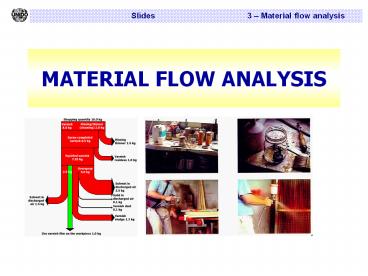MATERIAL FLOW ANALYSIS
1 / 29
Title: MATERIAL FLOW ANALYSIS
1
MATERIAL FLOW ANALYSIS
2
Strategies for waste minimization
3
What are materials?
- Goods/raw materials (e.g. wood, gravel, PVC)
- Elements (e.g. carbon, cadmium)
- Compounds (e.g. benzene, methane)
4
What is a material flow analysis?
- A material flow analysis is a systematic
reconstruction of the way a chemical element, a
compound or a material takes through the natural
and/or economic cycle. - A material flow analysis is generally based on
the principle of physical balance. - Definition of the Commission of inquiry
"Protection of human life and the environment" of
the German Bundestag
5
Initial situation in a paint shop
6
Material flows in a car repair shop
7
How does a balance work?
- Input mass
- Output mass
- Storage
- (Without
- chemical
- reaction)
8
Material flow analysis and eco-balances
- Eco-balances
- Analyse the whole life-cycle of a product
- Analyse the ecological effects
- Assess the material and energy consumptions
emerging during a life cycle and the arising
environmental effects.
9
Objectives of a material flow analysis
- Trace the flow of raw materials through the
company to establish connections within the
process - Retrace waste and emissions to the point where
they are generated - Identify weak points (inefficiencies)
- Define the basis for evaluation
- Edit data in a decision-oriented way
- Set priorities for appropriate measures to
minimize waste and emissions
10
Criteria for the selection of a material
- Quantity of the material flow
- Costs of the material flow
- Toxicity of the material flow
- Legal aspects of the material flow
11
How to carry out a material flow analysis?
- 1. Define the objectives and parameters to be
monitored - 2. Limit the balance scope
- 3. Limit the balance period
- 4. Identify and define the process steps
- 5. Draw the flowcharts material flows quality
- 6. Draw up the balances material flows
quantity - 7. Interpret the results and draw conclusions
12
Material flow analysis of machine painting
13
Step 1 Parameters monitored
- Paints, solvents, (all process materials)
Step 2 Balance scope
Painting chamber and drying
Step 3 Balance period
1 year
14
Step 4 Process steps of machine painting
- Process steps
- Pre-treatment
- Priming, painting
- Drying
- Additional equipment
- Steam generator
- Exhaust air filter
- Cleaning of spray gun and container
15
Step 5 Flowchart
- Representing process steps by rectangles
- Representing material flows by arrows
16
Step 5 Flowchart
17
Step 5 Flowchart
Paint, thinner, filler, tape, film, air,
container
18
Step 6 Balances
- Input output for the whole system
- Input output for the single steps
19
Step 5 Flowchart
A2
20
Quantitative material flow analysis
21
Quantitative material flow analysis
22
Step 7 Interpretation
- By identifying parameters
- Calculation of the so-called application
efficiency" - Dry surface film mass Efficiency
_______________________ -
Input solid state mass - In this case for small pieces lt 10
- In this case on average lt 20
- State of the art?
23
Typical efficiencies (application efficiency,
expressed in solids)
Conventional 35-50
HVLP 50-70
Airless 40-75
Electrostatic 50-85
Rotating disc 75-90
Dipping 90
Pouring 95
Rolling 98
24
Evaluation of a material flow analysis
25
Evaluation of a material flow analysis 2
- Possible parameters
- Efficiency factors (ratio of use to costs)
- Quality factors (ratio of real efficiency factor
to the theoretically possible efficiency factor) - Linkage with costs
26
Data sources
- Accounting
- Warehousing
- Collection of process data
- Operational accounting
- Personal information (e.g. methods engineer)
- Estimates
- Measurements
- Original documents
- ...
27
Measuring water volumes
- Water meter
- Turbine wheel meter
- Rotameter
- Induction measuring instrument
- Ultrasonic flowmeter
- Weir
- Measuring at water consumers
- (stop watch, bucket)
2,5
0,31 h 2g
o
q
tan o
28
Recommendations 1 for a material flow analysis
- Carry out the material flow analysis in steps
- An estimate is better than doing nothing at all
- Even with estimates it is possible to improve
- 80 90 of accuracy is sufficient
- Use simple measuring instruments
- Use indicators
- If necessary, contact the supplier or plant
manufacturer
29
Recommendations 2 for a material flow analysis
- It is not essential to follow the instructions or
procedures in great detail, a creative approach
is often helpful. - Even by simply working with the balances you can
sometimes achieve improvements. - It is important to translate the results into the
language of the respective target group (monetary
units, kg, pictures, comparisons, etc.)































